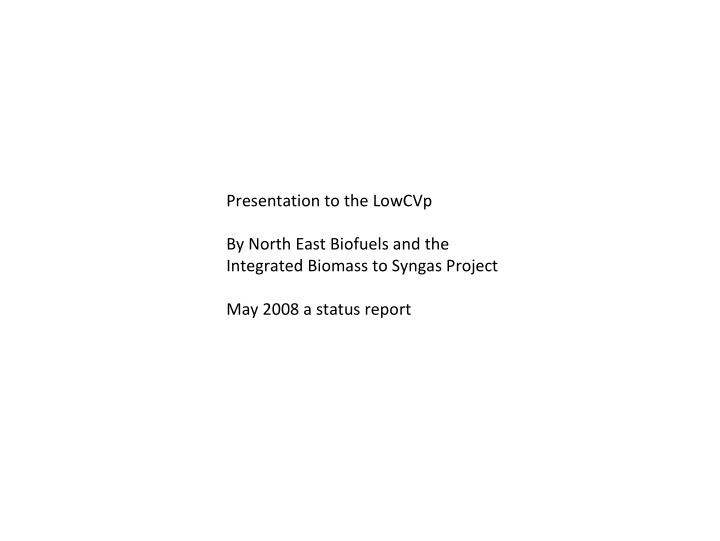



Presentation to the LowCVp By North East Biofuels and the Integrated Biomass to Syngas Project May 2008 a status report
NEB has identified that the UK has the potential to manufacture more than 1mt per annum of Synthetic fuels by 2020 using thermochemical conversion technologies. As a first step the Integrated Biomass to Syngas Project – IBS has been set up. The IBS project is specifically designed to define and gain support for the first practical steps to achieve the 1mt goal by focusing on identifying immediate ,realistic ,business opportunities. As such the IBS project will help to define projects for the 2008 – 2014 timeframe.
Why focus on Synthetic Biofuels? • Has 90% less Green House Gas impact than current diesels. • Is made from lignocellulosic ,non food ,Biomass. • Could contribute to 34% of the UK’s biodiesel obligation • Is a higher quality fuel with added value Potentially £800m capital and 6000 jobs Targeting aviation and transport sectors
WU1
Slide 4 WU1 To illustrate the ghg benefits proclaimed by the automotive industry Windows User, 13/05/2008
A Biorefinery Complex WU2
Slide 5 WU2 To illustrate that the most efficient solution would be a joint thermal / bio-chemical and chp facility Noting that the NEB IBS project is focusing on the thermal route. Windows User, 13/05/2008
WU3 UK BTL IMPLEMENTATION PLAN ( Technology) 2007 2008 2009 2010 2011 2012 2013 2014 2015 2016 2017 2018 2019 2020 R&D activity Torrefaction Gasification & FT Forestry, agriculture, MSW Demonstration activity Torrefaction operate Pyrolysis finance, design, construct & operate BTL demonstrator Finance, design, build & operate Gasifier scale ups SRC planting Timber programme MSW contracts Commercial and technology plan Consortium appointed BTL Refinery design finance & construct Pyrolysis / torrefaction products available
Slide 7 WU3 Overall timetable to show the limited time for R&D and development of crops. Windows User, 13/05/2008
IBS project support from - DEFRA The project has also received support from: Peter Harrison – The Business Project Office Ian Waller - FiveBarGate Consultants
Integrated Biomass to Syngas Project – IBS Main objective: To establish a business led team focused on developing a business based on thermochemically derived syngas. Due November 2008. Main deliverables 1.A review of current developments leading to a view of the immediate business opportunities. Due June 2008. Objective: To use this view of opportunities to facilitate engagement with business. 2.A third party analysis of greenhouse gas and capital profiles of alternative thermochemical conversion routes. Due September 2008 Objective: To be used as a reference for the sustainability of Biomass to Liquids projects 3.A business / plot plan describing the most practical business options. Due September 2008 Objective: To be used as a basis for raising funds and support for further work.
IBS Project Review – key findings to-date 1.Pyrolysis and Torrefaction both provide benefits for biomass densification. 2.Gasification technology is well developed but little experience with large scale biomass. 3.Obtaining a clean syngas is key. So using waste wood or variable feedstock is complicated. 4.UK has limited and uncoordinated R&D in this area. 5.Developing a synthetic route to fuels is more about Process Engineering than research. 6.Could encourage existing technology development into the UK and /or support opportunities to leapfrog with own tecchnology.
IBS Project – End products What Fuels could be produced? The easiest option will be to upgrade pyrolysis oil as a crude oil replacement to go into a refinery for Gasoline and Diesel. DME would be the cheapest fuel to produce. With Methanol a close second. A synthetic fuel, BTL, involves greatest capital requiring oil at $135/bbl + 35p support. Commercial technology is being developed to take Pyrolysis oil + VGO to Diesel and Gasoline at scales under 200tpd.
How could Lowcvp help? 1.Now a. Inform members and shareholders. b. Develop a market led view of preferred fuel products c. Encourage members to support the projects goals. 2.Post IBS project – October 2008 a. Review the projects conclusions and consider how to build on them.
Recommend
More recommend